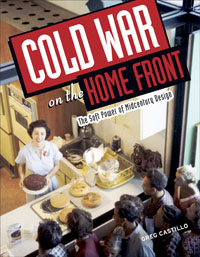
Greg Castillo
SPECIALIZATIONS
Architectural history; design discourses and practices.
PHILOSOPHY STATEMENT
As a proponent of interdisciplinarity in research and teaching, I conceive my role as that of a mediator among fields of knowledge production. My twin goals are to offer architects a broader awareness of the political and social content of design artifacts, and to convince "mainstream" historians that the study of built environments is central to a nuanced understanding of societies and cultures. Just as my research embeds design analysis into broader historical narratives, my teaching examines built form, aesthetic theory, professional politics, and their interaction in producing social outcomes.
BIOGRAPHY
Greg Castillo, who is also a Research Associate at the United States Studies Centre at the University of Sydney in Australia, specializes in the architectural history of Interwar and Postwar America and Europe. His course offerings include seminars on spaces of consumption, countercultural design in the ‘60s, transatlantic transfers of architectural practices, a global survey of modernist architecture, architectural history research methods, and a writing and publication workshop.
Castillo's research explores the design legacies of the Cold War, focusing primarily on divided German as a case study site. Areas of related investigation include urban reconstruction, reformation of the design profession and construction labor practices, and the creation of domestic and public environments as the supporting infrastructure for new postwar subjectivities. Castillo has presented public lectures on his research at the New York Museum of Modern Art; the Victoria and Albert Museum, London; the National Gallery of Denmark, Copenhagen; the Wien Museum, Vienna; the National Museum of Singapore; and the Woodrow Wilson International Center for Scholars, Washington DC. He has received research fellowships from the German-American Fulbright Commission, the Getty Research Institute, the Kennan Institute for Advanced Russian Studies, the Canadian Centre for Architecture, and the Ford Foundation.
COURSES TAUGHT
ARCH 170B An Historical Survey of Architecture and Urbanism, 1750 to the Present
ARCH 173 Case Studies in Modern Architecture
ARCH 179 The City as Theater of Modernity
AWARDS & RECOGNITION
Fulbright Fellowship, German Fulbright Fund (Summer Seminar on German Visual Culture), 2004
Association of Collegiate Schools of Architecture “Best Scholarly Article Award,” 2004
Getty Research Institute Postdoctoral Grant, 2002/2003
Association of Collegiate Schools of Architecture Service Award, 2003
Visiting Scholar Appointment, Canadian Centre for Architecture, 2002
Short-term Residency, Kennan Institute for Advanced Russian Studies: 1998
Ford Foundation Doctoral Dissertation Fellowship: 1997/1998
Deutscher Akademischer Austauschdienst Research Fellowship: 1996/1997
Publications
Cold War on the Home Front: The Soft Power of Midcentury Design (Minneapolis, University of Minnesota Press, 2010).
“East as True West: Redeeming Bourgeois Design Culture, from Socialist Realism to Ostalgie,” Kritika 9:4 (Fall 2008). 747-68.
“The American ‘Fat Kitchen’ in Europe: Domestic Modernity and the Marshall Plan,” in The Politics of the Kitchen in the Cold War, Ruth Oldenziel and Karin Zachmann, ed. (Cambridge MA: MIT Press, 2008).
“Exhibiting the Good Life: Marshall Plan Modernism in Divided Berlin,” in Cold War Modern: Art and Design in a Divided World, 1945-1975, David Crowley and Jane Pavett, ed. (London: Victoria & Albert Museum, 2008).
“Promoting Socialist Cities and Citizens: East Germany’s National Building Program,” in Selling Modernity: Advertising and Public Relations in Modern German History, P.E. Swett, S.J.Wiesen and J.R. Zatlin, ed., (Durham: Duke University Press, 2007).
“The Bauhaus in Cold War Germany,” in Bauhaus Culture: From Weimar to the Cold War, Kathleen James-Chakroborty, ed., (Minnesota: University of Minnesota Press, 2006), 171-193.
“Domesticating the Cold War: Household Consumption as Propaganda in Marshall Plan Germany,” Journal of Contemporary History 40: 2 (April 2005), 261-288.
“Design Pedagogy Enters the Cold War: The Reeducation of Eleven West German Architects,” Journal of Architectural Education 57:4 (May 2004), 10-18.
“Peoples at an Exhibition: Soviet Architecture and the National Question,” in Socialist Realism Without Shores, Thomas Lahusen and Evgeny Dobrenko, ed. (Durham: Duke University Press, 1997).
“Gorky Street and the Design of the Stalin Revolution,” in Streets: Critical Perspectives on Public Space, Zenep Çelik, Diane Favro and Richard Ingersoll, ed., (Berkeley and Los Angeles: University of California Press, 1994), 57-70.
“Housing as Transnational Provocation in Cold War Berlin, Transnationalism and the German City, Janet Ward and Jeffrey Diefendorf, eds. (New York: Palgrave Macmillan, 2014), 125-140.
“Le Corbusier and the Skyscraper Primitives,” Architectural Theory Review, Vol 18, No. 1 (April 2013): 8-27.
“Making a Spectacle of Restraint: The Deutschland Pavilion at the 1958 Brussels Exposition,” Journal of Contemporary History, Vol. 47, No. 1 (2011): 97-119.
“American Modernism,Triumph and Transformation: 1952-1968,” in Helge Bofinger and Wolfgang Voigt, eds. Helmut Jacoby: Master of Architectural Drawing, (Wasmuth/Deutsches Architektur-Museum, 2001) 34-45. Chinese translation, Dailan Univ. of Technology Press, 2003.
“Stalinist Modern: Constructivism and the Soviet Company Town, ”in James Cracraft and Dan Rowland, eds., Architectures of Russian Identity, 1500 to the Present (Ithaca: Cornell Univ. Press, 2003), 131-149.

